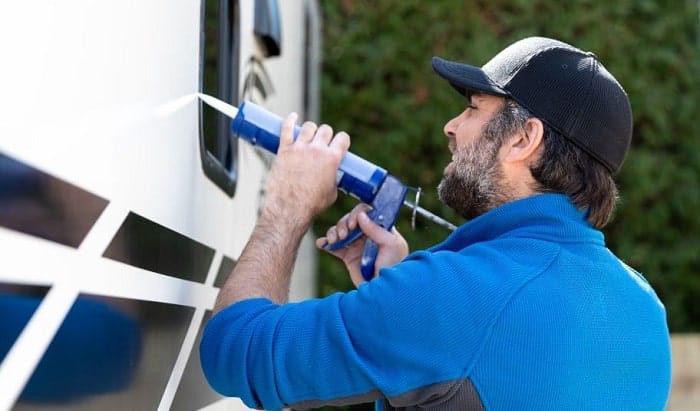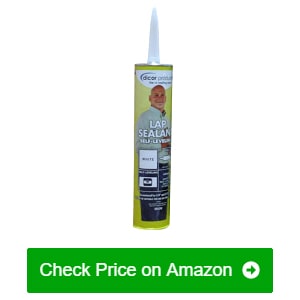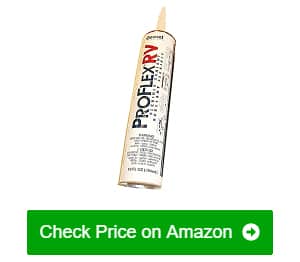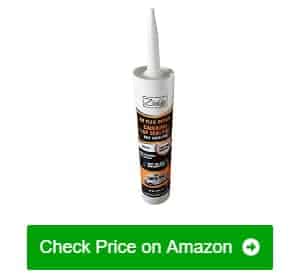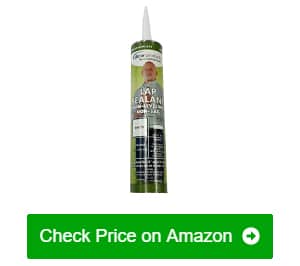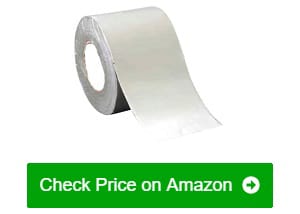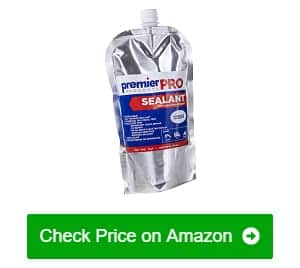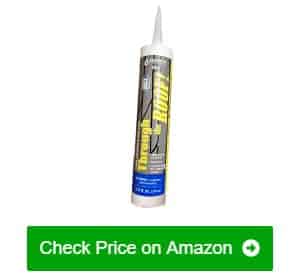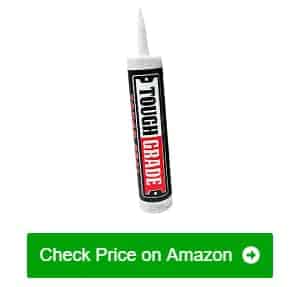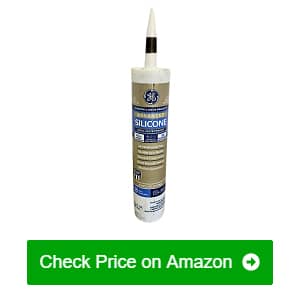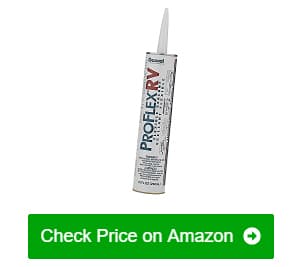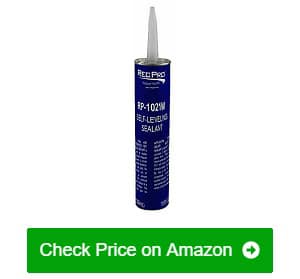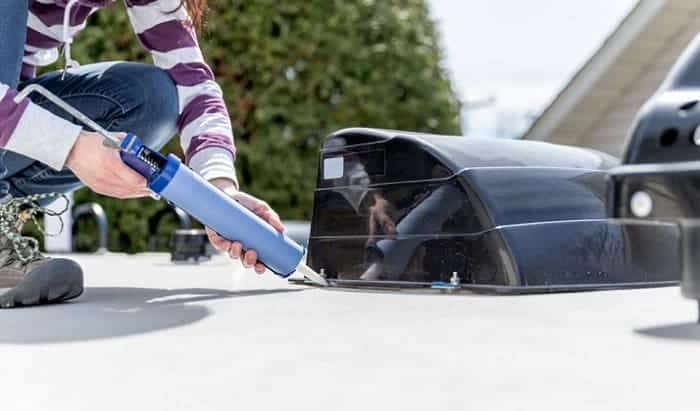If you want your RV to last for many years, paying close attention to the roof is necessary. Note that the smallest leak can lead to all sorts of serious and expensive damage. The most efficient way to fix or prevent leaks is to use the best RV caulk.
The first thing to keep in mind is that if enough water were to get inside the ceiling, it can cause dangerous short circuits in the electrical wirings. If you are lucky, you might just get a blown fuse but the crossed wires may still cause a fire.
Furthermore, the damp environment from leaks facilitates the growth of molds and mildews. These invasive fungal spread quite fast, seriously compromising the strength of the materials that they grow on. Most molds and mildew sare also major health risks.
In this article, you will learn about different kinds of RV roof caulk, what type of caulk to use on a camper, some RV caulking tips, and how to tell which ones do a good job. You can also access some short product reviews, making it easier to decide which one is worth your hard-earned money.
Table of Contents
Best RV Caulk Reviews
1. Dicor 501LSW Self-Leveling Lap Sealant
This RV roof sealant from Dicor works best on RV roofs as it is self-leveling, meaning it can be applied without getting your hands dirty. The Dicor lap sealant pumps out easily. It also has the consistency of a slightly runny toothpaste, which is the reason why it can level itself on the surface effortlessly.
Although it is not advisable to use it as the only camper sealant, the Dicor RV caulk is effective as a secondary sealant. It means that if you want your RV’s roof to be completely watertight, you can apply a tall bead of this RV trim sealant over the existing caulking. It will greatly increase the service lifespan of your vehicle as you almost certainly guarantee that no amount of moisture can get inside.
Another thing that I liked about this sealant is that it can adhere to almost all kinds of materials that you can find on an RV. Even if your vehicle has a rubber (EPDM) roof, it can still stick on it effectively. You can also use it on aluminum, wood, vinyl, and even galvanized metals.
Another nice feature of this RV caulking product is that it does not harden and will still be quite flexible for some time after the application. This incredible amount of flexibility means you can use it on the seams that are constantly subjected to vibrations.
- Easy to apply since it flows out of the nozzle without any trouble.
- Features self-leveling formulation
- Compatible with various materials but formulated mainly for rubber roofs
- Does not crack and remains flexible even after some time
- Can withstand strong vibrations and extreme temperature fluctuations
- The packaging is quite feeble and easy to burst.
2. Geocel 28100V RV Flexible Sealant
If you are looking for the best caulk for fiberglass RV, you need to get something like the Geocel Pro Flex RV caulk. Aside from being strong, it also flexes well, meaning it can absorb the vibrations created by the vehicle as it hits bumps and dips in the road. It is not like other kinds of caulk that crack and shatter because they dry rigidly.
Another reason why I highly recommend the Geocel Proflex RV sealant is that it can adhere to different surfaces. It is even useful when the said surface is damp. I also think that it is the best RV caulking to have around in your RV just for the mere fact that you can use it for emergency fixes regardless of the weather outside.
If a leak suddenly springs on your roof while raining, you do not need to wait for the rain to stop, and just let the leak cause more damage by the minute. I also find it the best caulk for the RV roof thanks to its ease of use. Unlike other flexible caulking products, it does not string up like hot mozzarella cheese.
The only problem is that if you try to smooth it out using your finger, it will get a bit messy. Apart from this, this product offers a clean application as there is hardly any residue to clean up later.
However, if you spray a bit of soapy water over the bead, you can easily even out the RV sealant caulk without it sticking to your finger.
- Strong while remaining flexible
- Can absorb a lot of mechanical vibrations without deteriorating
- Can adhere to damp or wet surfaces
- Does not string up unlike other grouts and sealants
- Compatible with most RV surfaces and materials
- Quite tacky when first applied
3. Ziollo RV Flex Repair Caulking Lap Sealant
I find this RV caulk impressive with the lifetime warranty it offers, which proves that it can last the service life of your RV. If the brand’s promise holds true, it will be the last roof sealant for RV that you will ever need to buy.
Aside from lasting virtually forever, this lap sealant is also user-friendly. You do not also need to make as much preparation to the surface to be applied compared to other RV caulks and sealants.
However, you can expect it to adhere much better on properly prepared surfaces. This caulk is also self-leveling, which means you do not need to spread the material by hand after application. If you apply a bead that is high enough, it will spread out on its own and make an even patch of material over the seepage that you need to seal.
Another nice thing about this product is that it does not fully shrink nor harden up when it dries. It tends to stay flexible after being completely cured. Being relatively soft and plasticky allow it to absorb vibrations, expansion as well as contraction of different parts on the RV.
However, do note that there are also downsides to this high-quality caulk. Although I did not experience it myself, some customers have complained that they received tubes of caulk that were already dry inside. Still, most people used this product with satisfactory results so the dry caulk tubes might have been isolated cases.
Despite that, it is still advisable to check its production and expiration date just to be on the safe side.
- Comes with a lifetime warranty, virtually outlasting the usability of your RV
- Easy to use and tends to self-level after application
- Dries and cures quickly without waiting for an entire day
- Does not shrink nor dry up too much
- Stays flexible even after curing
- Needs to be extra cautious during purchase to prevent buying a tube with dry and cured content
4. Dicor 551LSW Roof Lap Sealant
I think that this product from Dicor is the best caulk for RV exterior. This is because, as the name implies, it will not sag after application. It also means that this product is not self-leveling, so you must level it out on your own.
Not only is it suitable for flat and level surfaces, you can also use it on vertical surfaces without worrying about it running. I’ve applied it on the windows and sidings of my RV and it adhered promptly without running down the side. With that, I can say that it is one of the best RV window caulks I have used so far.
I also find this product impressive as it is versatile enough that it can adhere to various surfaces. I discovered that it is useful on aluminum, plastic, and even fiberglass without causing any problems. I am convinced that this caulk will work not only on all RVs, but any products that require a watertight seal.
Another nice quality of this product is its ability to stay flexible even after it dries. It is a great feature for the components of the RV that you use constantly, like air vents and windows.
Although it is a non-sag sealant, it is efficient in fixing leaks onroofs as well. It even did such a wonderful job that I spent several tubes to make the roof completely watertight. Also, although its bright white color contrasted quite a lot with the black rubber roof, it was paintable so it now blends in with the rest.
- Does not sag after application, making it perfect for vertical surfaces
- Promotes perfect consistency without the risk of running after application
- Can adhere to almost any surface imaginable, even on glass and plastic
- Dries and cures quickly
- Remains flexible even after curing completely
- Not that robust packaging
5. Beech Lane RV Permanent Repair Tape
One thing I liked the most about this product is that it is in the form of a 4-inch wide tape, which makes the application process a whole lot easier. No longer do I need to load a tube onto a caulking gun, just need to layout enough tape to cover the area and press it into place. Every application went on evenly every time with little to no mess.
Another nice thing about this product is that it can adhere to different kinds of materials. It stuck effortlessly onto the EPDM roof of my RV and did not peel off even a bit. According to the manufacturer, this repair tape can stick onto most metals, EPDM, and even wood. I even used this caulk for my RV shower, and it is still doing great after more than a year.
Although there is no way I can tell if it will last for as long as the manufacturer claims, where they guarantee that the tape will last up to 20 years of continuous exposure to the outdoor elements. It is a bold claim when talking about roof sealant for RVs. I can tell, though, that it can last at least a couple of years without drying up and cracking.
Furthermore, Beech Lane promises to refund or provide replacements in case you have any issues that may arise after using the product. This tape is also flexible even after it has completely cured. It is great for the roof because it can stretch a bit to compensate for the thermal expansion of the roof panels.
- Easy to use and applies evenly every time
- Can supposedly last up to 20 years
- Can adhere to almost any surface on RVs
- Requires minimal surface preparation – You just need denatured alcohol to clean up the surface.
- Remains flexible even after curing
- May sometimes rip apart when peeling off the silicone liner
6. Premier Pro Products RV Roof Sealant
First off, this sealant comes in a pouch, which might come as a shock for some folks, especially those who usually use caulking guns. However, I gave this product a try and I was impressed by it. The nozzle is just the right size for placing a good line of sealant over seams and holes that needed patching.
The biggest benefit of the Premier Pro roof sealant is that you do not need to purchase a separate caulking gun. Just squeeze the pouch and a uniform amount of sealant will go out of the nozzle. What’s more? Unlike caulk guns, this sealant comes in a resealable pouch, so it is easy to store if you have a lot of leftovers.
Don’t you just hate it when you place a line of sealant along a vertical surface, like the exterior wall of your RV, and then the stuff just runs down and makes a huge mess? This is not a problem with the Premier Pro roof sealant because it has a non-sagging formulation. With that, it will not spread out unless you take a brush and flatten it.
Even though it does not run nor sag, it stays flexible after it finishes to cure properly. It somewhat proves the ability of the caulking to withstand vibrations, twisting forces, and expanding gaps during hot summer days.
You can rest easy knowing that your RV’s roof now has complete protection against even the most challenging weather.
- Comes in a handy and resealable pouch
- The mixture has the consistency just right to promise no running or sagging
- Does not require the use of a caulking gun – Just squeeze it directly from the packaging
- Remains flexible even after it has dried and cured
- Can withstand strong vibrations and stretch to make up for thermal expansion
- Quite big nozzle for small repair jobs
7. Sashco Through The Roof Sealant
There is a reason why Sashco Through the Roof is one of the best-selling products of its kind – and that is the fact that it works well. If you are looking for a long-term roof repair solution, then it will not disappoint. Through the Roof works several times better than silicone sealant and I can attest to that.
I used it on my RV roof for a quick repair a couple of months ago (without any preparation whatsoever) and it is still holding on strong. Another reason why I love this sealant so much is that it is virtually invisible. Unlike other sealants that you need to paint over, you can just leave this as is because it dries and cures crystal clear.
If I did not apply the sealant on the roof myself, I would not notice it. This Sashco lexel caulk for RV is also one of the best choices to use during an unexpected repair job. For instance, when you suddenly need to climb up the roof during a rainy night because of a sudden leak.
This sealant will adhere to the roof surface even if it is completely wet, so there is no need to wait until the rain subsides. In other words, the leaks won’t get the change to create water damage. Flexibility is an important feature that should be present in an RV roof sealant.
The other upside of this product is that it can deal not just with the vibrations of the vehicle, but also the expansion of the roof due to the heat of the sun. Through the Roof sealant remains flexible even after several months or years have passed since application. This product guarantees that it will not dry up and crack unlike other roof sealants available.
- Dries and cures crystal clear
- Lasts twenty times longer than asphalt roof sealant
- Remains flexible even after many months
- Can adhere even on wet surfaces
- Easy to apply because it has the right consistency
- Dries up rather quickly
8. ToughGrade Self-Leveling RV Lap Sealant
If you will be doing some general repairs and maintenance work on the roof of your RV, then I highly suggest using the ToughGrade lap sealant. You will be getting a good quality sealant at an affordable price, so you can easily afford a couple tubes of this stuff to cover all the parts that need servicing.
As the name suggests, it is a self-leveling lap sealant. It means that you do not need to brush this sealant after application. It will flatten and spread itself out evenly across the surface of the roof. It also does not dry quite as fast as others so you will have plenty of time to make sure that it has spread adequately. If there are some parts where the sealant did not level out, you can still brush it to even it out.
This product is also UV-stabilized, preventing it from being easily deteriorated under the harsh sunlight. Furthermore, It will not turn yellow after many months of use. It can even maintain its flexibility and prevent itself from drying and becoming chalky. Painting over this stuff to make it blend better with the rest of your roof is, too, an option.
Another thing I liked about it is that it adheres to almost all surfaces, even bare aluminum. I did a total renovation on the roof of my RV by stripping it down to the bare metal. Even then, I still noticed that this sealant stuck onto the surface easily.
If it adhered well to a surface like aluminum, then it will have no trouble adhering to other smooth surfaces like fiberglass or plastics. The biggest issue I have with it is that it easily hardens once you open the packaging.
- Affordable while still delivering similar performance to more expensive rival brands
- Self-leveling, cutting the application time by nearly half
- UV-treated, preventing it from deteriorating and dealing with discoloration
- Can adhere to most surfaces, including aluminum
- Allows you to paint it over, making it blend with the rest of the roof
- Easily hardens even with a capped nozzle
9. GE Sealants & Adhesives GE5030 Advanced Silicone Door Sealant
Of course, the first thing to look for when shopping for roof sealants is the weatherproofing feature, and I am glad to say that GE’s advanced silicone sealant is one of the best in this regard. If you feel a cold draft coming from the edges of your doors and/or windows, then it is probably time to apply caulk along their edges.
This product is also a good investment with its ability to repel mold and mildew. It prevents even the smallest amount of moisture from getting inside the seams of your RV. It means that there will be no suitable habitat where fungi can live and thrive.
This silicone caulk is also adhesive. It can stick to almost every surface imaginable, including smooth ones like glass or plastic even when they are still a bit wet. Moreover, it dries and cures quickly. After just 30 minutes of drying, it will be ready for heavy rains.
This silicone caulk is non-sagging, too. It means that it also works as an RV caulk for vertical surfaces, like the edges of windows and doors. You can use it that way without worrying about the product running. The bead of silicone will remain in place unless you use your finger, or a piece of hard plastic, to even it out and make it look more uniform.
You can also use it for horizontal components, like sealing the roof vents of an RV. Just make sure that you spread it out evenly. I do not have any problem with the product itself except for the packaging.
- Provides excellent adhesion to almost any surface
- Can be applied onto a surface that is still damp
- Completely dries and cures after just 30 minutes
- Non-sagging formulation, making it ideal for vertical surfaces
- Stays flexible even after the passage of many months
- The packaging is not that strong and is prone to punctures
10. Gorilla Clear 100 Percent Silicone Sealant Caulk
Gorilla is one of the most popular adhesive brands in the world, so you can be sure that their silicone sealant will also follow the same standard of quality as their other product lines. I used this sealant on virtually any problem that I can think of on my RV. With that, I can say that it is a versatile caulk.
You can use it for both indoor and outdoor applications. I have experience using other silicone caulks, but most of them are not quite as good as Gorilla in terms of user-friendliness. Once dried, this caulk’s transparency helps it blend with the surrounding so nicely that you would not be able to tell that it is there without a magnifying glass.
It is great for applying caulk on the exterior of the RV, like around the window panes and on door jambs. I also used it to make a seal around my drop-down kitchen sink and it is almost invisible to the naked eye. I also find it resilient. Even if it has completely dried, it does not get all hard and brittle.
This caulk will look and feel as if you just applied it yesterday. It will not shrink nor turn yellow. Best of all, it will not develop any cracks even after a year or two. It will remain quite pliable for many months, making it ideal for use on RVs.
Another nice feature of this caulk is that it is resistant to mold and mildew growth. Other caulks do nothing to stop mold and mildew, that is why you can often see them growing on and around the caulking.
Gorilla caulking resists and prevents mold and mildew by not providing them with a source of moisture, which is what they need to grow and thrive. The only problem that I encountered with this silicone sealant is that it is too clear and shiny.
- Highly versatile, making it stick onto virtually any surface imaginable
- Dries clear, promoting ease in hiding it
- Does not get hard and brittle when dried since it remains flexible and pliable
- Resists the growth mold and mildew
- Completely waterproof and can resist large fluctuations in temperature
- Dries too shiny, making it look like it is perpetually wet
11. Geocel 28101V RV Flexible Sealant
This RV roof caulk is a great addition to any RV owner’s toolbox. There have been several times when this flexible caulk rescued me from sticky situations. Aside from working effectively in sealing RV roof seams and patching holes, I am also glad to say that it is a highly versatile adhesive.
It can stick onto various materials and surfaces, so you can use it for whatever task you might have. Another reason why I liked this caulk is that it remains flexible even when it’s completely dried and cured. With that, I find it ideal to use on RVs because it can withstand rigorous vibrations.
Moreover, it can flex to cope with the thermal expansion of the seams and joints. This RV roof sealer can resist the UV-rays of the sun, therefore making it good for roof problems. It does not harden nor turn brittle, even when you expose it for hours on end underneath the rays of the sun.
This sealant will not also get discolored, so if you apply it on a white surface, it will not turn an ugly shade of yellow even after a long time. I also like how easy it is to apply. Unlike other sealants and caulks, it does not string when applied. It means you do not need to worry about any messes after the application.
It lets you finish your tasks much faster and without as much hassle. The only thing that I did not like about this product is the long drying time. If the weather conditions are just right, it will still take a little over 24 hours for this sealant to cure.
- Does not harden nor crack even after many months
- Can adhere to a lot of different surfaces
- UV-resistant since the sun’s rays will not discolor or dry out this caulk
- Dries completely white without the risk of it turning yellow
- Does not string when applied and tends to stick on surfaces cleanly
- Takes a while to dry and cure completely
12. RecPro 1021 Self-Leveling RV Sealant
One impressive thing about this RecPro product is that it is a true all-weather roof caulk/sealant. It does not matter if you live in the hot and humid Southern regions or nearer the arctic circle. This sealant will keep your RV leak-free for years.
It works well for different sealing tasks. Whether you are seeking to plug up holes or cracks in the roof or want to lay a bead down to seal up the seams around the vents, air conditioning unit, and other parts on your roof, this product is a perfect choice.
As mentioned in the name, the RecPro sealant is a self-leveling product. It means that it will spread out on its own without you having to brush it even. Just lay a bead that is thick enough and it will spread and flatten on its own.
If you have a white roof on your RV, then it is the perfect sealant to use as it will dry completely white. What’s more? It is UV-resistant and will not turn a sickly yellow color even after the passage of many months. Even if you do not paint over the sealant after it cures, you will not get any funky-looking discolored patches on your roof.
- Can withstand extreme heat and cold once dried and cured
- Self-leveling, making sealing your RV’s roof quicker
- Works as a multi-purpose adhesive, too
- Dries completely white and will not turn an ugly yellow even after a long time
- Easy to use with a good enough consistency that promotes ease in squeezing it out of the tube
- Will not self-level properly if it is too cold outside
Best RV Caulks Buying Guide
When shopping for an RV caulk, you should avoid buying the first tube you find on the shelves. Doing so may increase the chance of you buying the wrong kind. To make sure that you will not be wasting money on the wrong product, here are some of the factors to consider when shopping for an RV caulk.
What will you be using it for? – Think about the kind of damage you will be patching up using the said caulk because not all of them are created equal. Will you use it to plug up a hole in the roof? Will you be scraping off the old caulk from roofing panels?
If you will be replacing the caulking on the seams of the roof, it is better to use a simple acrylic caulk. However, if you will be patching a sizable hole or crack, something a bit more heavy-duty is more desirable.
What kind of material will you be fixing? – Not all kinds of caulk can work on all kinds of materials or surfaces. For instance, some caulks and roof sealants will not stick to fiberglass surfaces. Others, on the other hand, will not work with rubber roofs.
Check the kind of material used on your RV roof then read the label of the caulk to see if it can work on the material. If you get the wrong kind of caulk, it would just peel off after drying, thus leaving the leak unsealed.
Temperature and moisture conditions – These two factors are among the most important ones you have to consider. If you will be caulking a certain part of the RV that is constantly exposed to water, like the roof and the windows, then get a waterproof one. If necessary, choose one that you can apply even while the surface is still wet.
On the other hand, if the application is in someplace where the temperature is constantly at the high points, then make sure to get one that can take on extreme temperatures.
Ease of use – It is also crucial to choose an RV caulk that you can easily use. If you made a mistake while applying, it should also be easy to clean up. You should also be able to get it off using soap and water in case some of it gets into your skin accidentally. Those are just some of the things that contribute to the ease of use of the RV caulk.
Aside from that, the caulk should also be easy to apply. It should not be too thick that it takes quite a lot of force to get it out of the tube. It should not also be too runny. The consistency should be like toothpaste but a bit thicker.
Drying time – If you need a quick fix, then get a sealing caulk that dries and cures in just a couple of minutes after application. However, keep in mind that quick-drying caulks are not as effective as those that take a couple of hours to harden and cure.
However, if you need to use your RV immediately, it is alright to use a quick-drying caulk instead. Remember to replace it with something more substantial as soon as you can.
Performance – A good quality caulk should be able to adhere completely onto a surface upon application. There is nothing worse than a caulk that peels off even before it dries completely. Aside from sticking firmly on the surface that it needs to seal, it should also be able to level itself.
It means you do not need a putty knife to smooth the surface of the caulk, it should do so itself. Note that you will also be using the caulk on an RV, which is a moving vehicle. That said, it needs to be flexible enough so it can withstand the vibrations that the RV will be making while on the road.
Also, avoid accidentally buying a caulk that is for household use as it usually dries up and becomes brittle.
How Many Types of Caulks for RV Are There?
Several types of RV caulk are available in the market today with each one having its own set of advantages. Among these types are:
Putty tape – As you can probably tell from the name, it is a kind of putty that is in the form of tape for easy application. It is a self-adhesive tape used usually for sealing A/C ducts and vents.
Because it is in the form of a self-adhering tape, the putty tape is easy to apply and flattens evenly. It does not crack nor turn yellow and also adheres more to the surface with ages.
Elastomeric sealant – This type is one of the most used sealants on RVs and in households. Aside from patching holes, it has many other uses, like fixing leaking pipes, waterproofing surfaces, and many more.
Polyurethane sealant – This type of sealing caulk is flexible and can adhere well to different types of materials. It is ideal for use on RVs because it is still flexible even after it dries. It is also easy and quick to use.
Silicone sealant caulk – This caulk is versatile and durable that you can use on different parts of your RV. You can use it for sealing the edges of vents, windows, and other straight-edged components. You can use it on pipes, but it will require quite a bit of skill as you will be using a caulking gun to dispense the silicone sealant.
How Do RV Caulks Work?
RV caulk works straightforwardly. It is an adhesive substance you use for plugging up seams, gaps, and holes. This substance is soft and tacky when still inside its container, which is usually a tube.
However, once exposed to the outside air, it will start to dry and harden. When applied properly, caulking will create a solid and watertight seal that can potentially last for years.
Who Makes The Best Caulking for RV?
In all my years of being an RV owner, I have used my share of different RV caulking products. Among the numerous brands I’ve tried, the best ones include Dicor, Geocel, Ziollo, Beech Lane, Premier Pro Products, Sashco, ToughGrade, GE Sealants & Adhesives, Gorilla, and RecPro.
What Is The Best Sealant for Motorhomes?
If you are wondering what caulk to use on RV, then be aware that it will entirely depend on where you will be applying the sealant. For instance, in case you plan on applying it to the roof area, the best choice would be the one that can withstand different temperature extremes. It should be able to handle both freezing winters and harsh summer heat.
On the other hand, if you will be applying the sealant on a part of the RV that experiences quite a bit of vibration and movement, then choose one with a bit of flexibilityso it can absorb and withstand the mentioned conditions.
Ideally, keep a tube of RV caulking in your vehicle just in case the need for it unexpectedly arises. It is best to buy an RV caulking that is versatile and has many different uses for this purpose. You can never tell what kind of damage will suddenly pop up while you are on an RV trip so get a sealant that can cover most (if not all) of the cases.
How Do You Repair Cracked RV Caulking?
Unfortunately, you should not even try to repair RV caulking once it has cracks. It just means that it has become too old. Rather than trying to fill the cracks with even more caulking, it is better to scrape off the old caulk and apply a fresh layer in its place.
Trying to repair the cracks will not do you any good. The dry caulking has already become brittle at that point, and if you let it be for longer, it will turn into dust. Repairing the cracks will just be a cosmetic fix and not solve the issue. It.
How Do You Seal RV Seams?
Before doing anything, make sure it is sunny outside, or at least overcast because you do not want the surface you will be caulking to be all wet. Ensure that the caulk or sealant that you have is compatible with the material you will be using it with.
If you are not sure, check the owner’s manual of your RV. You can find a section there regarding caulking and sealants. Use a scraper to peel off the old caulking gently. If it has been a while since you replace the caulking, then it might come off in pieces; otherwise, you can pull on one loose end and peel the entire thing off in one piece.
Once the old sealant is off, thoroughly clean the surfaces that are to be applied with the caulk. This is to ensure that the new sealant will be able to adhere properly onto the surface. You can use denatured alcohol on a soft rag to remove even the smallest specks of dust.
Once you finish preparing the surfaces, carefully apply the caulking, making sure that you are applying an even and appropriate amount of caulking. Note that putting too much will make the seams look like it suddenly got blisters. Let the caulking dry and cure properly before you take the RV on the road again.
How Do You Use an RV Caulk?
If it is the first time that you will be using an RV caulk without any clue on how to use a caulk gun, you do not need to worry as it is quite straightforward, especially if you intend to apply it on the roof of your RV.
The first thing you have to do is to make sure that it is sunny outside and there is no chance of rain. Also, park your RV as far away from the nearest tree as possible because you do not want any leaves or branches to stick onto the caulk later.
Clean the RV thoroughly then let it dry completely. You can apply wax or polish if you want. Just do not get anything on the places that you will be applying the caulk. While polishing up the roof, look for any loose seams or holes that need patching up. If you have it, mark the places with a dry-erase marker so that you can easily find them later.
Load the caulk tube into the caulking gun as per package instructions. Gently press on the trigger to apply the caulk on the problematic areas. Do it gradually so as to prevent wasting any of the caulk.
Use a stiff piece of cardboard or thin piece of plastic to smoothen the caulk a bit. If you mess up the application, just scrape the caulk before it hardens and reapply. Allow the caulk to dry and cure for at least 24 hours before taking your RV out for a spin.
Care and Maintenance
After applying it to the surface and leaving it to cure properly, you do not need to do much in terms of care and maintenance on the caulk. It can last at least a year or so depending on how often you use your RV.
If you still have a lot of the caulk leftover in your caulking gun, just clean up the nozzle as much as you can and replace the cap. Also, make sure to screw it on tightly. As much as possible, though, use the remaining caulk as soon as you can.
Other RV Caulk We Reviewed
Sashco 13010 10.5oz Sashco Sealants
This product is a versatile RV caulk that you can use on almost any surface. It also dries clear, so you do not need to do much coverup.
Key Features:
- Dries clear and colorless
- You can paint over it, unlike silicone caulk.
- Can even work on slightly wet surfaces and is immediately waterproof upon application
J-B Weld 31319 RTV Silicone Sealant
If you will be joining or sealing a black surface, this black silicone can do the job effectively.
Key Features:
- Can dry and set in just one hour
- Cures to a dark black color
- Can resist the growth of mold and mildew
3M Marine Grade Silicone Sealant
3M has always been one of the best companies to make adhesives and other similar products. This o is not an exception.
Key Features:
- Works on plastic, glass, fiberglass, and metal
- Can resist freezing and high temperatures
- Extremely waterproof and formulated for marine environments
Tremco Vulkem V116GRY 116 Polyurethane Sealant
The neat thing about this caulk is that you can use it with minimal surface preparation. If you need a quick fix, it is the caulk that you should get.
Key Features:
- Can adhere even on primer-less porous surfaces
- Highly flexible, making it suitable for moving parts
- Can adhere to surfaces for up to 30 years
Permatex 80855 Clear RTV Silicone Adhesive Sealant
The problem that most people have with RV caulk is that it is quite difficult to conceal afterwards. It will not be an issue with this product.
Key Features:
- Dries clear and does not turn yellow with age
- Compatible with various materials, including metal, glass, and even fabrics
- Can resist high temperatures and vibrations while also being waterproof
AP Products 017-90891 White Sikaflex-221
Ask any contractor what their favorite caulk/sealant is, and most of them will most likely answer Sikaflex.
Key Features:
- Hardens and cures quickly; no need to wait at least 24 hours
- Can withstand bone-jarring vibrations over a thousand miles ride.
- Sand-able and paintable once dried and cured
Sashco 10016 10.5oz 10016 Big Stretch Caulk
This Big Stretch caulk can withstand not just vibrations but also extreme thermal expansion and other kinds of structural stresses.
Key Features:
- Highly elastic, which means that it does not dry up and crack
- Can keep out water and the weather for many years
- Easy to apply and possesses the consistency of slightly thick mayonnaise
Kohree Butyl Seal Tape RV Putty Rubber Sealant
This sealant from Kohree is a must-have item for all RV owners. If you need a quick yet reliable fix, then this one will be your best friend.
Key Features:
- Easy to apply as it always comes on evenly
- Can create a watertight seal
- Compatible with a wide range of materials/surfaces
Conclusion
Not that many RV owners even know that they have to re-caulk certain parts of their RV every now and then. However, do not just pick up the first caulk that you find on the shelves. You need to buy the best RV caulk so you can have the peace of mind that it will work as intended.
Now that you reached the end of this article, you have already gathered all relevant information when it comes to shopping for RV caulk. By getting a good caulk, you can properly maintain your RV so you can enjoy using it for many more years to come.

Hi, I am Tom Hank, an RV-er since 2014. Back then, I started without much help. As you can imagine, the struggles are endless. But now, you do not have to begin your adventures knowing next to nothing about RV lives.


